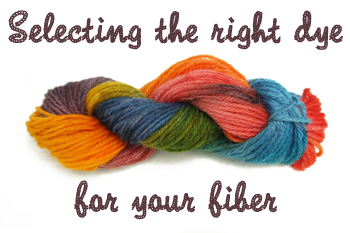 Dyeing your own yarn is the perfect way to customize your yarncrafting project, but not all dyes will work on every fiber. Before you begin, it’s critical to make sure you use the correct dye to ensure that your color comes out great. Consider this your cheat sheet for which common dyes will work with which fibers.
Dyeing your own yarn is the perfect way to customize your yarncrafting project, but not all dyes will work on every fiber. Before you begin, it’s critical to make sure you use the correct dye to ensure that your color comes out great. Consider this your cheat sheet for which common dyes will work with which fibers.
“Pantry” dyes: This isn’t an official term, but it’s how I cluster together food-safe acid dyes like sugar-free Kool-Aid, food color, sugar-free Jell-O, and Wilton icing dyes. These dyes are easy to use, so they’re great for blossoming dyers (click here for our Kool-Aid dyeing tutorail). These dyes work on animal fibers (wool, mohair, angora, alpaca, etc.) and blends with high animal fiber content.
Acid dyes (like Jacquard acid dyes): Don’t let the name intimidate you! Acid dyes are quite common, and most are safe for home use. They’re great for saturated colors and diverse effects. These dyes work with animal fibers, silk, and nylon, but they’re not effective on vegetable fibers or most synthetics.
Natural dyes: These dyes come from a variety of sources, including flowers, bark, fruit, nuts, spices, and more. These versatile dyes work well with both vegetable fibers (cotton, linen, hemp, etc.), silk, and animal fibers, but they can look very different depending on the fiber. Click here to see a comparison of a few natural dyes on cotton and wool.
All-purpose/union dyes (like Rit): These dyes are composed of two separate dyes — one that works on animal fibers, and one that works on vegetable fibers. That means that when you dye a 100% cotton yarn, it will only absorb up to half of the dye (the vegetable fiber type), leaving behind the dye that reacts with animal fibers. The inverse is also true: if you dye 100% wool fiber, the vegetable fiber dye will be left behind. If you’re dyeing an animal/vegetable blend (like a wool/cotton blend), both types of dye will be absorbed. This dye also works with rayon and nylon but not with acrylic or polyester.
Fiber reactive dye (like tie dye kits): Similar to acid dyes, fiber reactive dyes create brilliant tones. They produce vibrant colorfast shades on vegetable fibers and silk. They can also be used to dye animal fibers (but make sure to use vinegar or acid instead of soda ash).
There are other types of dyes available, but these five are the most common. If you’re looking to dye acrylic, the above methods will not work. Look for iDye Poly, a dye specifically designed for acrylic and polyester.
Remember, the most important part of dyeing is having fun! This is your opportunity to experiment with color and create something one-of-a-kind.
Related links:
You must be <a href="https://blog.lionbrand.com/wp-login.php?redirect_to=https%3A%2F%2Fblog.lionbrand.com%2Fyarn-dyeing-selecting-the-right-dye-for-your-fiber%2F">logged in</a> to post a comment.
Anne July
Just a comment on color choice in the ads; for us old folks to keep from squinting to read the info, please choose darker colors. The Gold color used in the entry pasted on Feb. 27 was not very easy to read. Thanks for a wonderful weekly newsletter and free patterns! Love it!
Anonymous
 Thanks for your comment, Anne. I’ll pass along your suggestion.
A Look at the Different Properties of Wool Yarns: Facts to Know In Selecting The Right Yarn for Your Project | Lion Brand Notebook
[…] Fishermen’s Wool is 100% undyed, virgin wool with natural lanolin oil. Lanolin oil is a waxy natural substance found in sheep fleece that acts as a water repellent, which makes Fishermen’s Wool ideal for accessories or garments for skiiers and fishermen. Wool can absorb up to about 30% of its weight in moisture, while still allowing you to feel warm and dry. Since wool takes dye easily, a skein in Natural or Oatmeal would be nice for experimenting with creating your own hand dyed yarns. If you’re more interested in learning about dyeing, and appropriate dyes for your yarn, take a look at this previous blog post by Jess, Choose the Right Dye for Your Fiber. […]
Ankit malik
Very nice post, you have explained great tips that which type of dye is suitable for which type of yarn. I will use natural dyes for my cotton yarn. Thanks a ton for sharing this useful information.
J Smith
I haven’t made anything with it yet, but I did dye a big skein of white LionBrand kitchen cotton late last fall. I can red beets, which are boiled to loosen the skin for easier removal. So, I always end up with a big sauce pan full of beautiful beet-juice saturated water. I hated just pouring it away. I pre-washed the yarn skein in a garment bag with some similar clothing to hopefully increase the ability of the yarn to hold the dye (based on what I read online).
The yarn turned out to be a nice pink color. If I do this again, I will wind the yarn into something more like a hank. The skein form makes drying the yarn a challenge. You live and you learn, right?